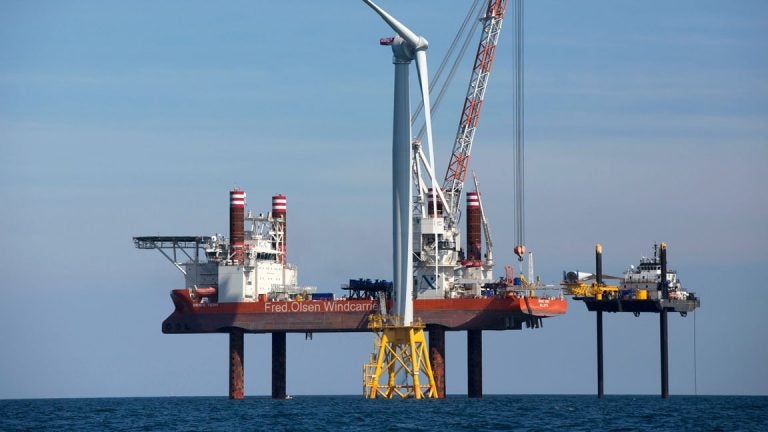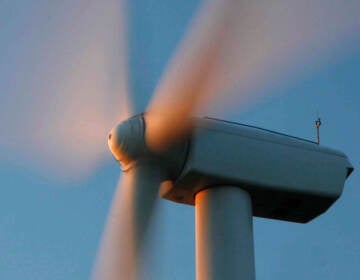N.J. to study environmental impacts of offshore wind projects

Aug. 15, 2016, a wind turbine, front, being assembled off Block Island, Rhode Island. (Michael Dwyer/AP Photo)
New Jersey officials will commission studies on the environmental impact of offshore wind energy projects on animals as large as whales and small as clams.
The research is designed to address a major concern raised by opponents and even some supporters of the nascent industry. The studies seek to establish the baseline data needed for assessments of ecological changes resulting from wind farm construction and operation.
The state Department of Environmental Protection and the Board of Public Utilities said Wednesday they are funding $3.4 million worth of projects to study conditions in commercially valuable clam beds that will overlap with wind turbine farms, and to study the topography of the ocean floor including sunlight conditions, temperature and carbon dioxide levels.
The state also will join Connecticut, Maryland, Massachusetts and New York in the Regional Wildlife Science Entity, designed to coordinate regional monitoring and research of wildlife and marine ecosystems that support “the advancement of environmentally responsible and cost-efficient offshore wind power development.”
The three initiatives will cost over $3.4 million. The money will come from the Offshore Wind Research & Monitoring Initiative, which is run by the DEP and BPU using money donated by two of the largest offshore wind developers: Atlantic Shores Offshore Wind and Orsted’s Ocean Wind II. The two companies have committed about $26 million to ecological research and monitoring of offshore wind operations, according to the state.
“As the stewards of our vibrant coastal and ocean resources, my colleagues and I at the Department of Environmental Protection are committed to the continuing pursuit of research and monitoring initiatives that will help us to ensure the responsible development of offshore wind facilities and their long-term maintenance and operation,” said Shawn LaTourette, the DEP commissioner.
BPU President Joseph Fiordaliso said the research will include collecting critical baseline data on whales and their movements along New Jersey’s coastline.
The program plans to solicit proposals for a passive acoustic monitoring project to better understand the movements and behaviors of whale species, including the endangered North Atlantic Right Whale, in the waters along New Jersey’s coastline.
That project will be part of a larger effort involving state, regional, and federal entities to protect marine mammals as offshore wind farms are developed along the eastern seaboard.
Atlantic Shores’ lease area is approximately 10 miles off the southern New Jersey coast and has the potential to power nearly 1 million homes. Orsted’s Ocean Wind lease area is approximately 15 miles off the southern New Jersey coast and has the potential to power nearly half a million homes.
Some of the most frequently voiced concerns from opponents of offshore wind are that not enough is known about how the turbines and buried undersea electrical transmission cables will affect the environment.
New Jersey is rapidly becoming a hub of the fast-growing offshore wind industry. Late last month, six companies bid a combined $4.37 billion for the right to build wind energy projects on the ocean floor off New Jersey and New York in the U.S. government’s largest such auction in history.
That’s in addition to three offshore wind projects already approved by New Jersey regulators.
The state said it will soon issue a request for proposals from entities interested in carrying out the research.
WHYY is your source for fact-based, in-depth journalism and information. As a nonprofit organization, we rely on financial support from readers like you. Please give today.





